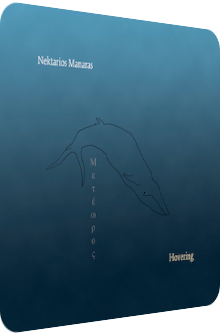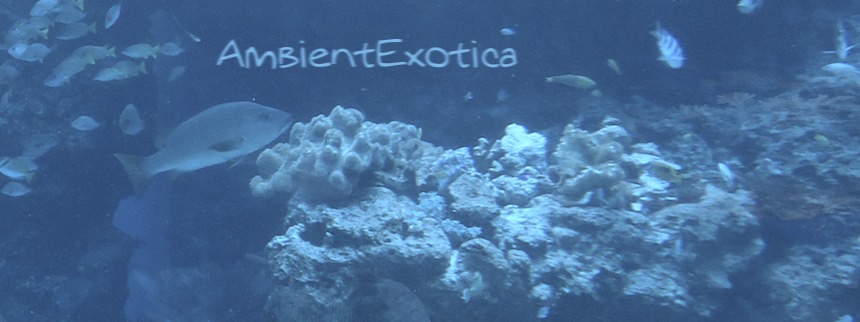
Nektarios Manaras
Hovering
2013
Hovering is the solo debut of Nektarios Manaras who is hailing from the Greek island called Chalkis, comprising six poly-faceted Ambient arrangements which are released in May 2013 on Kate Carr's Australian Flaming Pines label, a crib that focuses on sound sculptures about birds, rivers and the human perception of nature. Without a single field recording, Manaras delivers a glowing coral-colored ode to the magnificent magic of hazy Drone washes which are coupled with acoustic instruments whose origin are both easily distillable and hard to grasp. The amount of processing, i.e. hall effects and reverberated sustains, are only partially responsible for the masking of some instruments. The actual reason is rooted in the exoticism that wafts around this release. Instruments like the monomer and the fujara are largely unknown to me, even though I have surely encountered them – accidentally or not – in the Exotica section of this website. These are but two instruments to make up the paradisiac, carefree and at times astonishingly contemplative atmosphere of Hovering. However, classic pianos, drum kits and guitars were washed ashore in Chalkis as well. Despite being the solo debut of Nektarios Manaras, he is also in a band called Eziak and sure enough receives some additional aid from fellow band member, drummer and percussionist Vagelis Varis, Fontas Athanasiou on the specifically shimmering nylon string guitar, Nikos Fokas on the piano as well as on the helm of the iridescent glass effects, and the Athens-based Zenjungle on the saxophone. Manaras himself does not only play exotic instruments, but also knows how to handle the more conventional flügelhorn, additional guitars and cymbals. Says Manaras: “The main idea is that everything in the universe and earth is floating in such a beautiful way. That is the feeling I'm trying to capture with my music.” Can he (re-)unite the earthen surroundings and aquatic semi-barriers with space, and how is the latter depicted on this album? Is Hovering torn between these two allegorical places, or even torn apart by them? I cannot provide an erudite answer, but can unravel a few stylistic particularities and gorgeous tendencies for sure.
Still hazy, hued in a blue-grayish effulgence, but unbelievably euphonious and enchanting: After The Rain does not waste any time to prove it is the most splendid opener this album could possibly have, and I so hope that listeners and readers interested in the Flaming Pines label decide to check out these luminescent synth coils and glittering pads (listen to After The Rain on SoundCloud). This prelude alone gleams and is yet coated in diffusion. Manaras, however, is keen to move on by using the technique of vignetting. Soon enough, rustic Folk guitar twangs are united with Pagan flutes of the pondering kind, admixing a New Age feeling to the scenery that would – hear, hear – also ennoble many an Exotica record of the vintage era. After roundabout four minutes, the dualistic opener wanes, but leaves an enormous impression thanks to its mesmerizing and captivating textures. Sei In A Dive continues the journey with deep electro-acoustic bass drones, organ pedal-like flecks and a rather convoluted, opaque melody on the flute that reigns in Middle Eastern territories timbre-wise. The almost sawtooth-resembling drone buzzes of the bass frequencies only boost the enigmatic yet becalming Glitch-perturbed atmosphere further. Especially the short polyphonous bursts of green-tinted flute-evoking splinters are a verdure-driven nod to an otherwise technologically based, rather harsh and potentially cold subgenre. The bassline experiences processing in the veins of oscillation and stereo-panned tremolo chops. Sanguine piano chords and guitar licks conflate with the silkened bass apparitions and take over the steering in unison while eldritch strings screech in the distance. Now firmly rooted in a Jazz ambiance and ever-shifting between warmth and murkiness, Sei In A Dive eventually reaches the very sun-dappled hammock-friendly state the explanatory text mentions, but remains a shady, strangely luring phantasmagoria overall.
The aqueous rhizomes of Floating In Anything are rooted in a similar shadiness than the previous track, but this track inherits a strongly glowing nucleus which brightens up the unexpectedly uplifting and upbeat erection with hypnotic rhythms comprising nylon string guitars, mildly sizzling hi-hats and a clear cut beat structure created on a classic drum kind. The – unfortunately all too fleeting – signature elements are the delicately crunchy shakers which cover a ground somewhere in-between an archetypically croaking guiro and the granular grain of a maraca. They cut through the aural air like flashing thunderbolts, a stunning and best of all non-gimmicky inclusion. But Floating In Anything focuses on an entirely different cavalcade anyway, namely on a ginormously tranquilizing blurry loop of strings akin to Jan Jelinek's Loop-Finding-Jazz-Records (2001) that is then united with a mellowly spiraling flügelhorn melody and psychedelic guitar globs. The horn evokes that lonesome-melancholic film noir flair which I deem applicable even 70+ years later. But even this is not what Nektarios Manaras has in mind in terms of the song's conclusion, for in its final stage, it begins to orbit around Space-Age glitters and gorgeous fog banks of bliss. Floating In Anything… only the first word of the title seems astute. For Manaras and friends rather float in everything. The next track, however, leads them to the null space: Three Sketches Of Meteora is Space Ambient par excellence, as cheesy this genre depiction may seem on your display. The fade-in phase unfolds a brazen gunmetal-colored nebula supercharged with those dissonantly screeching strings of the György Ligeti kind, but the Greek sound designer immediately interweaves a counterbalancing transcendental stratum in the shape of mollifying electric piano molecule gatherings that remind of far-away lullaby melodies. The interplay between dreamy drones, twinkling star dust, reverse clicks and a gently reverberated flügelhorn in tandem with guitar fractals create a sense of profound fluxion, the relaxation factor is huge because the diorama is never overly wadded. The placid moments of contemplation are as important as the instances of coalescing sounds.
Anemone Dance harks back to the opener in an implicit manner, for it is the second instance where the artist not only wants to lure the listener with a skillful concoction of translucent surfaces, no, here he goes all-in and tries to overwhelm big time, as he already did on the gleeful-entrapping state of rapture on After The Rain. It so happens that the fragilely chopped undulation of Anemone Dance already emanates the Pop Ambient-like grandiloquence of the faux synth-fueled mirage that is about to grow and prosper. Feeling astutely bubbling and liquid, the main column creates a scintillating aurora which later denies its vesiculating form in order to morph into a legato stream, all the while exotic goblet drums and dusky saxophone layers gyrate around the blazing color range of the drone stream. The established rhythm is smoking fast in the given endemic surroundings and revs up both the energy and the evocation of a dance, but does not decrease the feeling of being encapsulated in a susurrant river of amicability and understanding. The song's aftermath consists of a wonderfully bucolic panorama of sun-soaked guitars and clinging tambourins. The large doses of echo nurture the feeling of being in an underwater cave, making this a fitting addendum. The finale is called Escaping The Orbit and suggests a galactic theme. Notwithstanding its title, the outro moulds several short vignettes into one track. From the airy-progressive gravity of the warbled crystals and threnodic strings over the following juxtaposition of the propulsive abyssal bass drones with multiple glass effects and pristine chimes to the purified beams of light with mellifluous flügelhorn cascades as the last segment of both the track and the album, Escaping The Orbit is a three-part heliosphere with a designed minimalism and the purpose of drifting along without an overarching purpose or intended goal after a string of incidental progressions. An unfortunately arbitrary-contingent finale to a multifaceted Ambient work.
Hovering lives up to the very promise its minimalistic title gives. Most Ambient albums do, but here the state of hovering, floating or drifting does not materialize by the means of monotonous drones or multiplied post effects, but two essential conceptions that are hard to achieve in the music-related world of overabundance: firstly, there are actual melodies on this release which often seem to be improvised or played live on top of a loop-based panorama whose cusps or zeniths are cleverly camouflaged in order to not feel like repetitive micro-movements at all. These melodies are not necessarily compatible to the vast Field of Pop, regardless of the way the listener loves, despises or interprets this blurriest of all genre notions, but they work so successfully due to a second marker which strikes, lures, hits, lifts up and embraces the listening subject with all its power. I am talking about the textures. Unprocessed acoustic layers meet instruments whose decay or sustain is altered via hall, echo or reverb, and moments later a moiré of them creates a deep flow which seems to be synthesizer-based. Regular readers know about my hit-or-miss pinpointing helplessness which is by tendency always wrong, so when I presume or even wager that the lilac-tinged, sunset-colored and incandescent drone washes are possibly maybe synth-based, they are decidedly not synthetic. But they feel like it. Even when Nektarios Manaras adds a beat to his arrangements, the languorous dreaminess is always upheld. The opener After The Rain offers a maximum of enthralling enchantment and blitheness in its first half, Floating In Anything and Three Sketches Of Meteora are galactosamine infusions shuttling between arcane nullity and earthen wondrousness, and Anemone Dance is an Ambient track whose relatively fast beat pattern is still easygoing and laid-back enough to fully soak in the textures of the drums in this already magnanimously aquatic piece. Hovering is a gem that should not be missed by fans of warm, polylayered Ambient structures with spacier undertones. Kate Carr's curation skills are a safe bet, Flaming Pines does not cease to amaze.
Further listening and reading:
- Listen to two tracks off Hovering at SoundCloud: After The Rain (full version – must listen!) and Sei In A Dive (excerpt).
- More info is available at the dedicated Hovering section at the Flaming Pines website.
- Follow the Flaming Pines label on Twitter: @FlamingPines.
Ambient Review 215: Nektarios Manaras – Hovering (2013). Originally published on May 8, 2013 at AmbientExotica.com.
